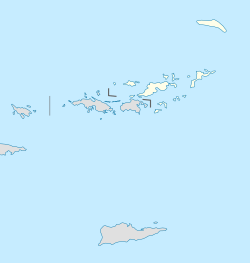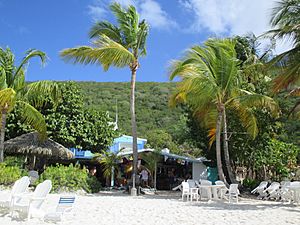Jost Van Dyke facts for kids

Jost Van Dyke
|
|
|
The location of Jost Van Dyke within the British Virgin Islands
|
|
| Geography | |
|---|---|
| Location | Caribbean Sea |
| Coordinates | 18°27′N 64°45′W / 18.450°N 64.750°W |
| Archipelago | Virgin Islands |
| Area | 8 km2 (3.1 sq mi) |
| Highest point | Majohnny Hill at 321 meters (1054 ft) |
| Administration | |
| British Overseas Territory | British Virgin Islands |
| Demographics | |
| Population | 298 (2010) |
| Additional information | |
| Time zone | |
| ISO code | VG |
Jost Van Dyke (often called JVD or Jost) is the smallest of the four main islands in the British Virgin Islands. It is about 8 square kilometers (3 square miles) in size. This island is part of the Virgin Islands group, located in the Atlantic Ocean and Caribbean Sea.
Jost Van Dyke is about 8 km (5 miles) northwest of Tortola. It is also 8 km (5 miles) north of Saint John. A smaller island, Little Jost Van Dyke, is just off its eastern side. Like many nearby islands, Jost Van Dyke was formed by volcanoes. It has mountains, with Majohnny Hill being the highest point at 321 meters (1,054 feet).
Contents
Exploring Jost Van Dyke's Past
Early Settlers and Pirates
The island might be named after Joost van Dyk. He was a Dutch privateer (like a legal pirate) in the 1600s. He used the island's harbors as a secret hideout. However, we don't have solid proof that the island was named after him.
One famous person from Little Jost Van Dyke was John C. Lettsome. He founded the Medical Society of London.
Life on the Island: From Sugar to Charcoal
The British took control of the British Virgin Islands in 1672. But Jost Van Dyke seemed to be mostly left alone until the mid-1700s. An old map from 1717 doesn't even show Jost Van Dyke.
Archaeologists have found signs of old sugar works on the island. This means people grew and processed some sugar cane there. By 1815, about 140 acres of land were used to grow cotton. The island had 428 people living there, including 371 enslaved people.
After slavery ended in the British Virgin Islands in 1838, the population of Jost Van Dyke kept growing. Many islanders traveled to St. Thomas to find work. By 1853, the island had 1,235 residents.
Charcoal Making and Fishing
After slavery ended, people on Jost Van Dyke mainly fished and farmed small amounts of food. Making charcoal became a big industry. People made charcoal by burning wood slowly in special pits. This was important for cooking and heating.
Between the 1920s and 1960s, a lot of charcoal was sent from the British Virgin Islands to the US Virgin Islands. On Jost Van Dyke, people often worked together to build these charcoal pits. These pits were also social spots. Women might bake bread, and men might play dominoes while the charcoal was being made.
Fishing and sailing were also very important. People became skilled at building boats and sailing them. Small local sailing boats, called "Tortola Boats," were common until the 1960s. Then, motorized boats became more popular.
Hurricane Irma's Impact
In September 2017, Hurricane Irma hit Jost Van Dyke. It was a very powerful storm. The island's hills lost most of their plants. The primary school, health clinic, and gas stations were damaged. Most homes on the island were destroyed.
The island's 298 residents worked together to recover. They set up a recovery center at Foxy’s Tamarind Bar and Restaurant. This place had the only working refrigerator and generators. Residents used a salvaged chainsaw to clear roads.
People and Tourism
Island Population
In 2010, the population of Jost Van Dyke was 298 people. The number of people living on the island has grown a lot in recent years. In 1991, only 140 people lived there. The island has many young people. Almost half (46%) of the residents are under 35 years old.
Visiting Jost Van Dyke
Many tourists visit Jost Van Dyke. You can get to the island by private boat or by ferry. Ferries run from Tortola, Saint Thomas, and Saint John.
Most visitors go to Great Harbour. The beach there has many small bars and restaurants. Foxy's Bar in Great Harbour has been a popular spot for boaters since the late 1960s. Foxy's and other bars are busy all year. They get thousands of visitors on New Year's Eve, which locals call "Old Year’s Night."
Great Harbour is one of the busiest ports in the British Virgin Islands. In 2008, nearly 7,000 boats checked in through the island's port. Today, tourism, especially yachting, is the main part of the island's economy.
Famous Beach Bars
Near Great Harbour is White Bay, home to the Soggy Dollar Bar. This famous beach bar is said to be where the popular drink called the Painkiller was invented. The bar got its name because there was no road or dock when it was built. Boaters had to anchor offshore, swim to the beach, and pay for drinks with wet money.
Today, White Bay has many beach bars. It's a very popular stop for yachts and boaters. Group tours and even small cruise ships visit White Bay often.
On the east side of Jost Van Dyke, you'll find Foxy's Taboo. This is a well-known lunch spot, bar, and gift shop. There's a dock for boats visiting for the day. Nearby, a natural rock formation called the Bubbly Pool is a fun attraction. It gets its name from the bubbles that appear when waves crash against the rocks.
Jost Van Dyke in Music
Jost Van Dyke has even been featured in music videos. The country music video for Kenny Chesney's 2002 song "No Shoes, No Shirt, No Problems" was filmed here. The video shows scenes at One Love Bar and Ivan's Stress-Free Bar. At these bars, people often mix their own drinks and leave their payment in the register. Kenny Chesney also mentions Jost Van Dyke in his songs "Somewhere in The Sun" and "It's That Time of Day."
Education on the Island
The British Virgin Islands government runs several schools. Jost Van Dyke has its own primary school. This school offers both primary and secondary education.
As of 2011, students attend high school on Jost Van Dyke for two years. After that, they travel to the main island of Tortola for the Elmore Stoutt High School. Students take a 7:00 am ferry to Tortola and return on the 4:00 pm ferry.
Images for kids
See also
 In Spanish: Jost Van Dyke para niños
In Spanish: Jost Van Dyke para niños







